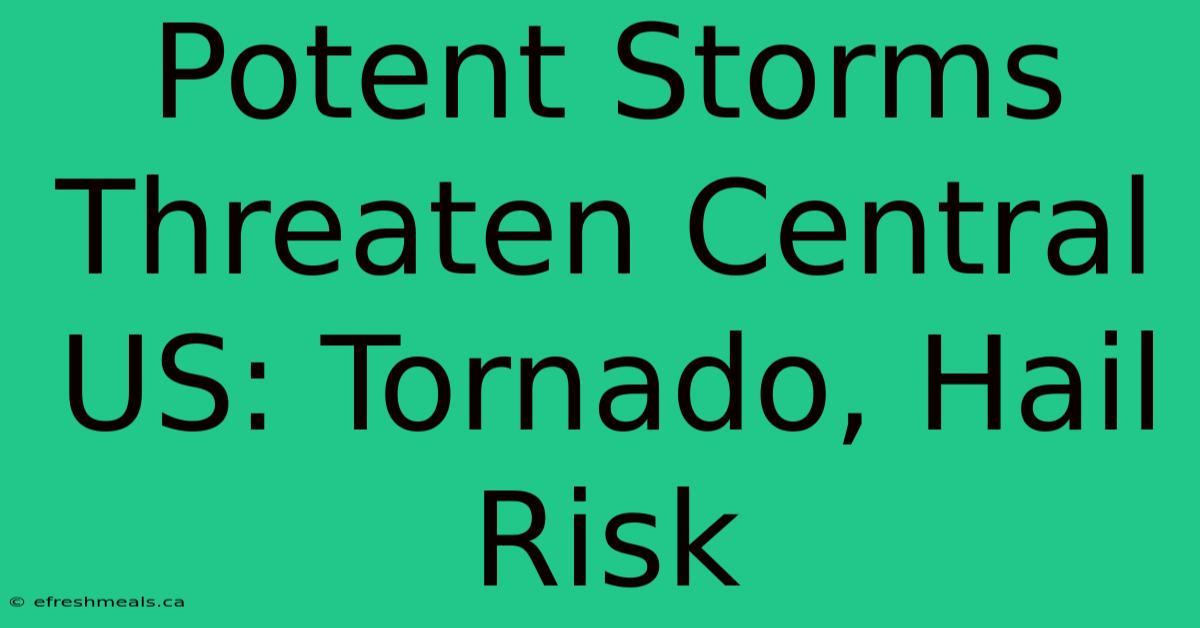Potent Storms Threaten Central US: Tornado, Hail Risk

Discover more detailed and exciting information on our website. Click the link below to start your adventure: Visit Best Website nimila.me. Don't miss out!
Table of Contents
Potent Storms Threaten Central US: Tornado, Hail Risk - Stay Safe!
Editor’s Note: A powerful storm system is currently moving across the Central US, bringing a significant threat of tornadoes and large hail. This is a critical situation that demands immediate attention and preparedness.
Why It Matters: Severe weather events can cause widespread damage, injuries, and even fatalities. Understanding the risks and taking necessary precautions is vital for protecting yourself and your loved ones. This article will provide key insights into this ongoing weather phenomenon, enabling you to stay informed and prepared.
Key Takeaways of Severe Weather:
| Category | Details | Impact |
|---|---|---|
| Tornadoes | Violent rotating columns of air | Significant property damage, potential injuries and fatalities |
| Large Hail | Ice chunks larger than 1 inch in diameter | Damage to vehicles, crops, and property |
| High Winds | Gusts exceeding 58 mph | Power outages, downed trees, structural damage |
| Flooding | Heavy rainfall overwhelming drainage systems | Damage to homes and businesses, road closures |
Potent Storms Threaten Central US
A potent storm system is sweeping across the Central US, posing a significant threat to several states. The National Weather Service has issued numerous warnings for tornadoes, large hail, and high winds, urging residents to stay vigilant and prepared. This weather event is characterized by its rapid development, unpredictable nature, and the potential for widespread damage.
Tornado Risks:
The rotating thunderstorms associated with this storm system are capable of producing powerful tornadoes, posing a severe risk to communities in their path. Tornado warnings indicate that a tornado has been sighted or is imminent. Immediate action is crucial to seeking shelter.
Factors Affecting Tornado Formation:
- Atmospheric Instability: Warm, moist air rising rapidly through cooler, drier air creates the necessary instability.
- Wind Shear: Changing wind speeds and directions at different altitudes provide the rotation needed for tornado formation.
- Lifting Mechanism: Fronts, boundaries between air masses, or strong updrafts can lift warm, moist air, triggering the storm process.
Large Hail Threat:
The intense thunderstorms accompanying this system can produce large hail, posing a risk to property and vehicles. Hail sizes are often categorized using a scale based on diameter. For example, hail larger than 1 inch is considered "large" and can cause substantial damage.
Factors Affecting Hail Formation:
- Strong Updrafts: Upward air currents within the storm cloud carry water droplets high into the atmosphere, where they freeze.
- Ice Pellet Growth: As ice pellets fall through the cloud, they collect moisture and continue to grow in size.
- Downdrafts: Strong downdrafts bring the hail to the ground, impacting areas with significant force.
Staying Safe During Severe Weather:
- Stay Informed: Monitor local weather reports from reliable sources like the National Weather Service.
- Have a Plan: Develop a plan for your family or workplace that includes emergency shelter locations and communication procedures.
- Seek Shelter: If a tornado warning is issued for your area, immediately seek shelter in a sturdy building's basement or lowest level.
- Stay Away from Windows: Windows are particularly vulnerable during high winds and hail, so avoid them.
- Protect Property: Secure loose objects outside, park cars in garages if possible, and protect valuable possessions.
FAQ for Severe Weather:
Q: What is a tornado watch? A: A tornado watch means that conditions are favorable for tornado development, but no tornado has been sighted yet. Stay alert and be prepared to take action if a warning is issued.
Q: What is a tornado warning? A: A tornado warning means a tornado has been sighted or is imminent. Take immediate action to seek shelter.
Q: How can I protect my car from hail damage? A: Park your car in a garage if possible. If that's not an option, try to find shelter under a covered area. You can also use a tarp or blankets to protect your vehicle.
Q: What should I do if I encounter a tornado? A: Seek shelter immediately in a sturdy building's basement or lowest level. Stay away from windows and stay informed through weather reports.
Tips for Severe Weather:
- Prepare an Emergency Kit: Include essential supplies like water, non-perishable food, first aid kit, flashlight, batteries, and a weather radio.
- Check Your Insurance: Ensure your home and vehicle insurance policies cover damages from severe weather events.
- Know Your Community's Emergency Plan: Familiarize yourself with evacuation routes and designated shelters.
Summary of Potent Storms in the Central US:
The current storm system sweeping across the Central US poses a significant threat of tornadoes, large hail, and high winds. Understanding the risks and taking necessary precautions is vital for staying safe.
Closing Message: Stay vigilant, heed warnings, and prioritize the safety of yourself and your loved ones. These storms can be unpredictable, so preparedness is crucial. Remember, being informed and prepared is the best defense against severe weather events.

Thank you for visiting our website wich cover about Potent Storms Threaten Central US: Tornado, Hail Risk. We hope the information provided has been useful to you. Feel free to contact us if you have any questions or need further assistance. See you next time and dont miss to bookmark.
Featured Posts
-
Best I Hate Gay Halloween Costumes
Nov 01, 2024
-
Halloween Fun For Dogs In Brussels
Nov 01, 2024
-
I Hate Gay Halloween Meme Social Media Backlash
Nov 01, 2024
-
Young Thug Sentenced Guilty Plea In Ysl Rico Trial
Nov 01, 2024
-
Lakers Draft Hood Schifino And Two Subsequent Picks
Nov 01, 2024
